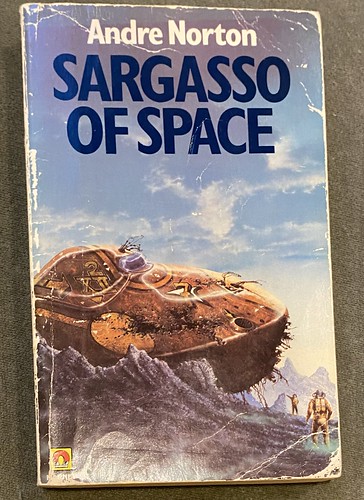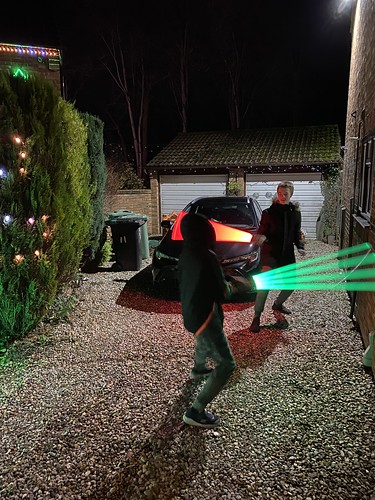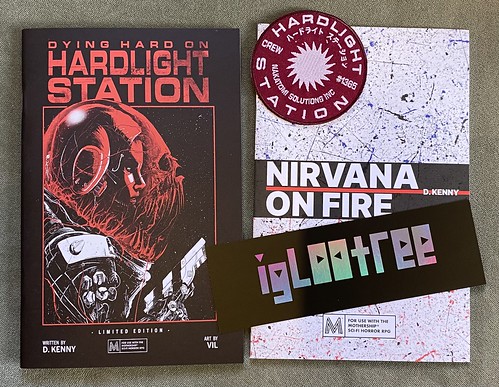
Our heroes have just emerged from the depths of a very strange library for the second time, bringing with them an injured woman, Ez D'Avenir. Now they need to decide what to do about the Abbot of St Markovia.
Our dramatis personae:
Ser Adon de Rouge of House Starbright (a half-orc Paladin, from a knightly background, with two human retainers and a priest), played by Paul (dr_mitch). Lawful Good. Married to Ser Alys.
Kelwarin (Kel) (a half-elf Sorceror flush with the powers of wild magic, an outlander), played by Graham (First Age). Chaotic Good.
Gaddock Teeg (a halfling wizard and former prizefighter), played by Alex (Doggetay), Neutral Good
Ser Alys de Adon-Rouge of House Starbright (a half-orc Fighter with a soldier background, currently the leader of the town militia of Daggerford), played by Tom (Guvnor). Lawful Neutral. Imagine a slightly greener take on Grace Jones... Married to Ser Adon.
also featuring:
Ireena Kolyana (a human warrior, daughter of the Burgomaster of Barovia, Twice-Bitten reincarnation of Strahd's unrequited love, Tatyana) - upgraded as a sidekick.
with :
Alexei the Vistana (a young human expert, sent to pay off his debt to the party by his Vistani elders after they rescued Arabelle from certain death when Alexei lost her in town. A late teenager who is so taken by Ireena and the excitement of the adventure that he's forgotten he planned to be sulky and surly for his 13 moon exile) - upgraded as a sidekick.
All characters are presently 6th level, including the sidekicks.
1st December (early evening)
Having exited the library, they gathered their wits and decided that they needed to find out what the truth was about the Abbot. Was he a fallen angel, or was he something else? Whilst discussing this, they were surprised that Clovin appeared unnoticed and started to chat to them. He led them down to the main hall where the Abbot and Vasilka were conversing, and Ireena, Alexei and the small group that they had rescued from the library were resting. A conversation of sorts was held, but it was almost as if the Abbot and his guests were skirting around the subject. After a short while, the Abbot and Vasilka retired for the night as the party said they were tired. Clovin, Otto and Zygfrek pulled pallets up from the store cellar and everyone bedded down for the night, with Kel taking the first watch. The party were clearly on edge. The plan? To wake up in the middle of the night and find out what was going on in the other wing of the building.
As they were whispering plans, Clovin appeared again at another inopportune moment, which they managed to cover up with a request for some more wine which he fulfilled with great enthusiasm.
2nd December (early hours)
They woke quietly and started to sneak out to check what was going on. Ser Alys almost blew the whole plan when she dropped her battle axe. She decided that she'd leave her armour and move in stocking feet to give herself a better chance to sneak around. Ser Adon carried his in his backpack. Alexei unlocked the door to the hall and they headed out into the cold, foggy night. The fog was lit through scant moonlight shining through the clouds above, giving a eery and disturbing feel to the night. Scouting through the fog, they found some of the strange half-bred creatures like Clovin locked in pens on the south wall. Gaddock saw something, hearing noises, perhaps the sound of bat wings. He decided to create a distraction with his owl, but when it tried to lift a slate to drop, it made a noise that woke something and then there were cries from more of the creatures they'd just found, calling for food. Something was looming in the mist, so Gaddock edged back and filled much of the courtyard with fog. The party formed a daisy chain to work around the northern side of the courtyard, as they'd seen no pens there when they walked through previously.
Concentrating on the spell, Gaddock was startled to discover that the person holding his hand in the fog was Clovin, who seemed to be very excited about the adventure they were going on. Quickly, Gaddock responded with a suggestion spell that Clovin goes back to bed, get some hot milk and go to sleep. He was very agreeable to this and headed off.
They reached the far end of the courtyard, and Ser Adon opened the bar that was locking the creatures in the Eastern wing. Sneaking in, Gaddock and Adon found a wrecked office, and then Ser Alys noticed that something was coming. A huge lumbering creature approached, sewn from multiple bodies, telling them they shouldn't be there and it would smash them if they didn't leave. It would tell the Abbot and Clovin that they were trespassing. Of course, it said this very slowly. Gaddock looked around the corner and agitated the creature, who thought he had escaped. It grabbed him and threw him into a cell. Ser Alys dived in after the halfling, while Ser Adon squared off with the creature, some form of construct.
In the cell, three sets of hungry eyes opened from their sleep and said expectantly, "Hungry? Breakfast?".
Outside the creature advanced on Adon and he tried to push it back.
In the cell, Gaddock emptied his ration pack for the creatures, who piled in, buying time.
Ser Adon managed to shove the creature backwards, allowing his colleague and wife to escape.
The construct roared in anger and started to chase after them. It battered Ser Adon backwards, slamming him into the walls.
As they fled, they realised that the cell opposite was teaming with more of these creatures, more deformed and basic versions of Clovin, Otto and Zygfrek. They ran. Exiting into the dark, they were relieved when the construct wouldn't cross the threshold of the wing.
They headed back to bed down, agreeing not to speak of this again.
Once they got back, they talked about what had happened and were joined again by Clovin who they'd woken up. He made them hot milk. They chewed over the Abbot's situation, the fact that Vasilka was obviously some type of construct, perhaps a doll to placate Strahd, and wondered if the Abbot had fallen. They were startled when the Abbot stepped out from the shadows in the room, noting how perceptive they were about his situation. He confirmed he had arrived over a century ago to restore hope following St Markovia's sacrifice and had tried to bring a change. This had not worked as well as he planned, and soon he was discussing the challenges of the Darklord of this domain with a nobleman who visited. The noble, one Vasili Von Holtz, provided information on rituals from the Amber Temple which allowed him to create life, after a fashion. He tried to heal the Belview family, but ended up creating mongrelfolk instead; the former humans were happy, but deeply twisted and were his wards.
The discussion ranged and he admitted that he was trying to create a creature that Strahd could love, a perfect bride. Every attempt by Strahd to calm his demons by finding Tatyana had failed, so this was a way to bring him comfort and to break the curse on the vampire and the land.
A lively debate ensued, with the group trying to convince the Abbot that this was the wrong way forward. He counterpointed that perhaps that could draw Tatyana's soul into Vasilka's body? Ser Adon debated with him that this was wrong. Ser Alys added his arguments, and then Kelwarin joined the conversation. He praised the industry and artifice that the Abbot had shown in the face of evil, and how he'd struggled for a solution born from love not hate. However, the Abbot had become obsessed and couldn't see that his scheme would never work; it wouldn't bring Barovia back to the light because Strahd was utterly gone, utterly evil and his own journal showed that he had embraced the dark powers before Tatyana killed herself for the first time. All his plan with Vasilka would do would be to damn the soul of an innocent to hell, because Strahd would never accept her or change.
A tear rolled down the Abbot's face. He muttered that Kel was right, was insightful and although not a man of faith, clearly a man of good. Turning to Ser Adon, he asked for his blade. The Paladin obliged. The sword burst into flame, a cold, clean, radiant energy of whites, blues and gold. The Abbot, looking more angelic than ever before sadly said that how he must remove the evil from this land, the corruption that he'd become. Ser Adon looked on horrified, Ser Alys looked on indifferent. Kelwarin, agast, argued with the fallen angel, telling it that the inmates here needed him, that they looked up to him, that he had done good in bringing light to a small part of Barovia. Somehow, he got through, and the Abbot passed back the blade to Ser Adon, also healing the warrior-knight as he did so.
They slept the rest of the night. In the morning, the Abbot told them that he would provide them sanctuary and what aid he could. He told them that if one of them died on this quest, they could bring them to him promptly as he may be able to return their soul to their body.
The party graciously thanked him, and planned to set out for Vallaki to try and find Jenny Greenteeth and see what she knew about the Fanes.
Ser Adon realised that his sword had absorbed part of the angel's energies and named it for the events of the night before, "Deva's Redemption".
GM Notes: This whole part of the scenario was gearing up for an extended swarm fight with the player, with them also facing off a fallen celestial. Instead, we roleplayed. Graham's in character roleplay was superb, and he had a dice roll to reflect that (high 20s critical) which actually beat the Abbot. They now have an ally or at least an alternative sanctuary. The scenario seems to be set up assuming that there must be a fight, but the players wanted to work their way around this. I was happy to oblige; it leaves a morally but partly redeemed angel as a player in Barovia and gives the party a good sanctuary. They now want to restore the Fanes and strip back some of Strahd's power before they face him directly. But will he insist on them taking up his invitation to visit first?\
Some fun roleplaying and clever use of magic this session.
1 December 2021






















